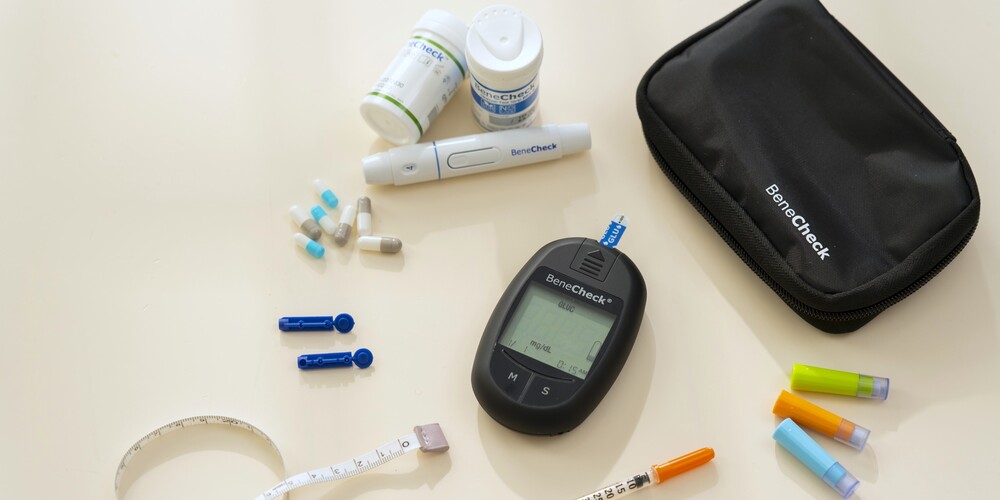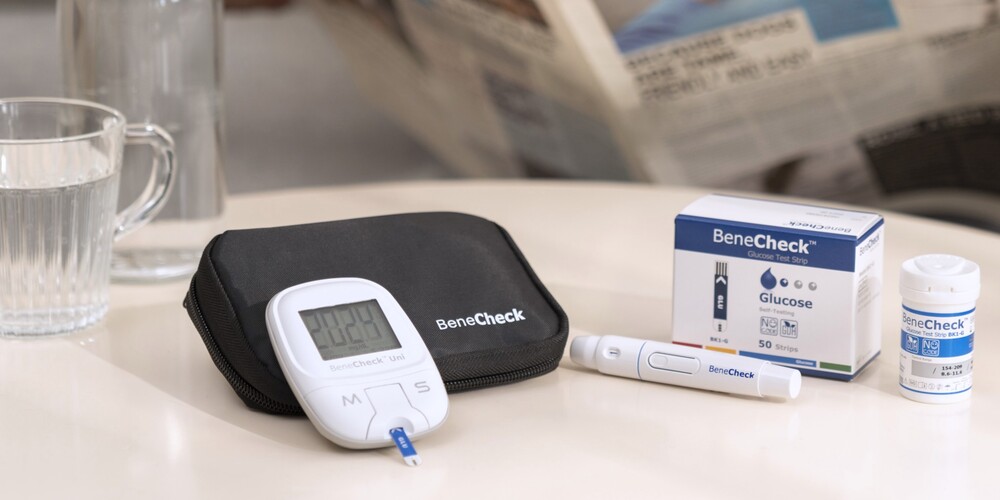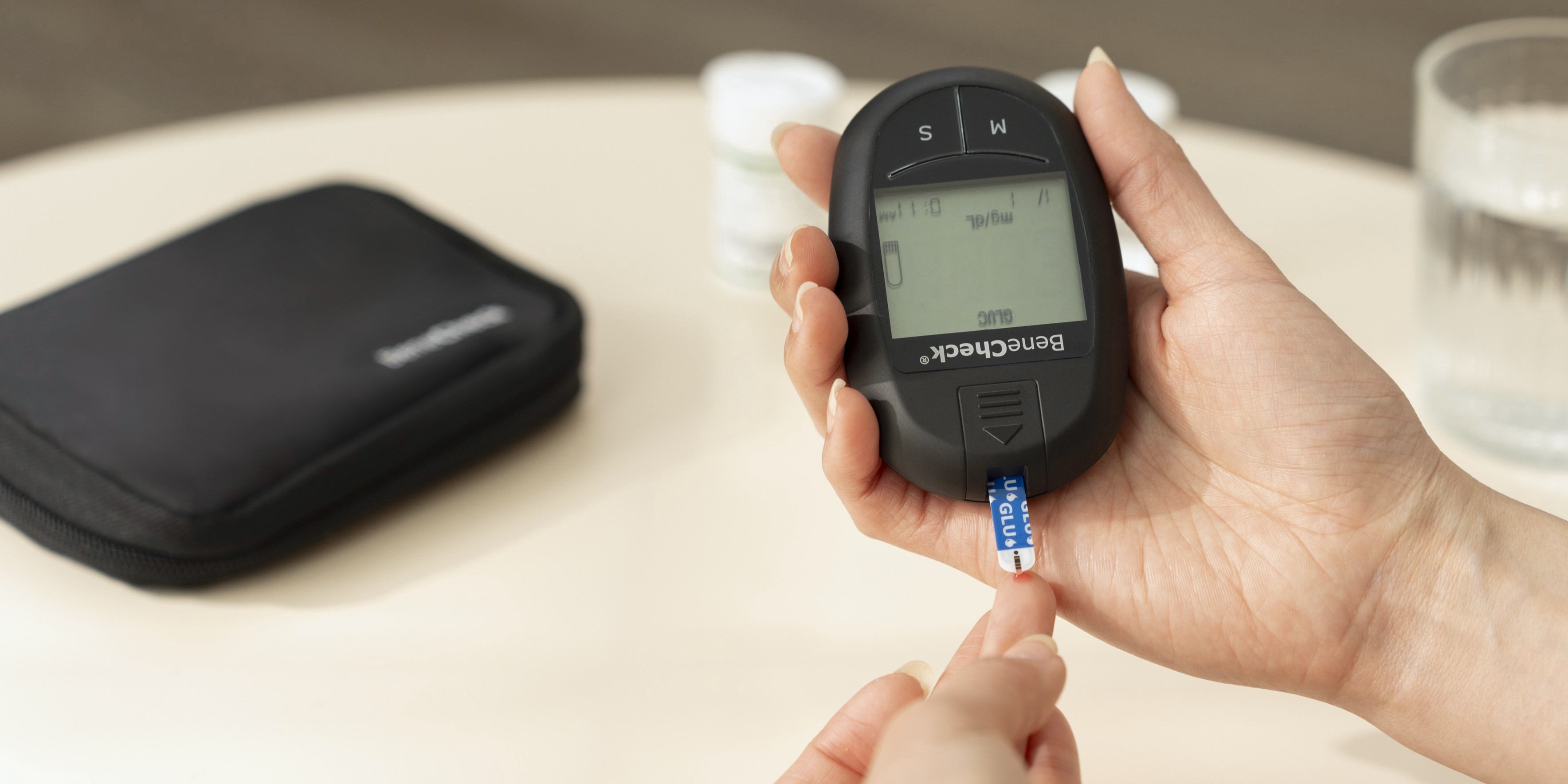How to Use a Glucose Meter and Test Strips: Easily Manage Your Blood Sugar at Home!

Whether you have diabetes or a family history of the condition, regular blood sugar monitoring is essential. While hospital check-ups are important, choosing BeneCheck Glucometer allows you to easily keep track of your blood sugar levels at home. By recording and observing your blood sugar readings, you can promptly detect any abnormalities and prevent potential health issues, ensuring a healthier life.
Who Needs to Monitor Their Blood Sugar Levels?
Regularly monitoring blood sugar levels is an essential part of personal health management for everyone. Certain high-risk groups, in particular, should undergo regular blood sugar testing to prevent the onset of diseases:
Individuals with diabetes or a family history of diabetes
Diabetes is a chronic condition that, if not properly managed, can lead to cardiovascular disease, kidney damage, diabetic retinopathy, and in severe cases, blindness. Therefore, regular blood sugar testing is crucial for diabetes management. However, it's not only those with diabetes who should be vigilant about their blood sugar levels. Individuals with a family history of diabetes are also advised to undergo regular blood sugar tests to detect issues early and take preventive measures to avoid disease progression. Diabetes can be categorized into the following two main types based on its causes:
〈More Infor: In Vitro Diagnostics - Diabetes Care〉
Type 1 Diabetes Patients
Type 1 diabetes is an autoimmune disease where the body's immune system attacks and destroys insulin-producing cells, leading to an insulin deficiency. It typically occurs in children or adolescents. The exact cause is unknown, and there is no cure; patients need to inject insulin to manage their blood sugar levels. It is recommended to monitor blood sugar frequently, about 4-8 times a day. These checks should be done in the morning before breakfast, before and after each meal, and before bedtime to accurately track blood sugar levels and adjust diet and medication accordingly.
Type 2 Diabetes Patients
Type 2 diabetes occurs when the body cannot effectively use insulin or does not produce enough insulin. It is most common in middle-aged and older adults and is often caused by environmental factors such as obesity and lack of exercise. Patients with type 2 diabetes are advised to check their blood sugar at least twice daily. This helps identify improper dietary habits or unhealthy lifestyle choices, allowing for timely adjustments to reduce the risk of complications.
Individuals who are overweight or obese
Being overweight or obese can lead to elevated blood sugar levels, increasing the risk of diabetes and other health issues. Regular blood sugar testing helps detect abnormal levels early, identify foods that impact blood sugar, and adjust dietary habits accordingly. Additionally, it supports the creation of a fitness plan to promote weight loss and overall health improvement.
Individuals with High Blood Pressure
Diabetes patients are at high risk for developing high blood pressure. Prolonged high blood sugar levels can damage blood vessels, leading to vascular issues and, ultimately, high blood pressure. Conversely, elevated vascular resistance can impair kidney function, causing fluid and sodium retention, which results in increased blood pressure. Given that diabetes and high blood pressure often occur together and both can lead to cardiovascular disease, regular blood sugar testing is essential for reducing these risks.
How to Choose a Blood Glucose Monitor
As blood sugar testing is crucial for managing health, it’s important to choose a highly accurate and user-friendly blood glucose monitor. With numerous brands and models available, here are some key factors to consider to select the best blood glucose monitor for your needs:

Compliance with Regulations and Proven Accuracy
The primary consideration when choosing a blood glucose monitor is accuracy, as precise readings are essential for effective blood sugar management. Therefore, it's important to select a monitor that meets government regulations and standards for reliability. Look for devices that adhere to international standards like ISO 15197:2013, have medical device permits from health authorities, or hold certifications from organizations such as the FDA (U.S.) or CE (European Union).
High Popularity for Easy Troubleshooting
Since a blood glucose monitor is used multiple times daily, it's advisable to choose a widely-used model. This ensures that test strips are readily available and that you can easily find online resources and support if you encounter any issues with the device.
〈More Info: FAQ〉
Ease of Use: Consider the Top 4 Functional Indicators
Aside from Type 1 diabetes patients, who are usually younger, Type 2 diabetes is more common among older adults. Therefore, the convenience of the blood glucose monitor is particularly important for them. To ensure ease of use for older individuals, consider these four key functional indicators to select the most suitable blood glucose monitor:
Compact Size for Portability
Regularly testing and recording blood sugar levels helps in effectively tracking the data. Therefore, opting for a compact and portable blood glucose monitor allows users to carry it with them at all times, ensuring they can perform their tests as needed, even when dining out or engaging in other activities.
Automatic Data Recording
Manually recording blood sugar values can lead to errors, affecting accuracy and potentially hindering diabetes management. A blood glucose monitor with automatic data recording is a great choice, as it minimizes the risk of mistakes and helps ensure more reliable tracking of your condition.
Low Pain Level for Blood Sampling
Since each test requires a blood sample, which can be uncomfortable for those sensitive to pain or squeamish about blood, it’s advisable to choose a monitor with finer lancets or those that require a smaller blood sample. These features can significantly reduce discomfort during testing.
Automatic Calibration and No Coding Required
When using new blood glucose test strips, forgetting to code the meter can lead to significant errors in readings. However, many modern blood glucose monitors come with automatic calibration features. These devices automatically recognize and adjust settings, ensuring accurate results and reducing the risk of errors, while also enhancing convenience.
Blood Glucose Monitor Operating Steps
Once you have your blood glucose monitor ready, you can start testing at home! By following these steps and paying attention to the details, you can avoid wasting test strips or making errors that could lead to inaccurate readings.
Preparation Before Blood Sugar Testing
-
Wash your hands with warm, soapy water and then dry them thoroughly.
-
Prepare the measurement tools: blood glucose monitor, test strips, lancing device, lancets, alcohol wipes, and dry cotton balls.
-
Insert the lancet into the lancing device and adjust the device's depth setting to control how deeply the lancet will puncture the skin. Higher numbers indicate a deeper puncture.
-
Take a test strip and insert it into the blood glucose monitor. The monitor will automatically turn on and enter standby mode when it detects the strip. After removing a test strip, immediately close the test strip container tightly to prevent moisture from entering and affecting the accuracy of the remaining strips.
Perform the Fingure Puncture
-
Disinfect the puncture site using an alcohol wipe. It is recommended to puncture from the side of the fingertip to minimize discomfort and reduce the likelihood of insufficient blood collection.
-
Press the lancing device firmly against the puncture site and press the button to perform the puncture.
Read the Blood Sugar Value
-
After squeezing out the first drop of blood, use a dry cotton ball to wipe it away to avoid any alcohol residue on the skin that could interfere with the test.
-
Squeeze out the second drop of blood and apply it to the blood glucose test strip. The blood will be drawn into the strip through capillary action.
-
After a few seconds, the blood glucose monitor screen will display your blood sugar level.

Post-Testing Cleanup
-
Apply pressure to the puncture site with a dry cotton ball to stop any bleeding.
-
Place used lancets in a container with a lid for safe disposal and take it to a medical facility for proper disposal.
What Are the Normal Blood Sugar Levels?
As noted, high blood sugar can lead to diabetes and other complications. So, how do you determine if your blood sugar levels are within the normal range? Here’s how to assess your blood sugar using fasting levels, post-meal readings, and HbA1c.
Fasting Blood Sugar Levels
Fasting Blood Sugar Normal Range: 70-100 mg/dL. For diabetes patients, blood sugar levels are typically higher than 126 mg/dL. If your levels fall below or exceed this range, it indicates poor insulin function and ineffective blood sugar control. Common warning signs of diabetes include frequent urination, weight loss, increased hunger, and increased appetite. Compare your blood sugar levels with these symptoms; if they match, seek medical evaluation promptly.
Post-Meal Blood Sugar Levels
Post-Meal Blood Sugar Levels: The normal range is 80-140 mg/dL. For diabetes patients, blood sugar levels are usually higher than 200 mg/dL. Post-meal blood sugar refers to the level measured two hours after eating. This value reflects how the food you have consumed has been broken down and entered your bloodstream, affecting your blood sugar levels.
HbA1c (Glycated Hemoglobin)
HbA1c (Glycated Hemoglobin): The normal range is 4-5.6%. For diabetes patients, levels are typically above 6.5%. Hemoglobin, a protein contained in red blood cells, becomes glycated when glucose attaches to it. HbA1c is used to evaluate the average blood sugar levels over the past 2-3 months.
Blood Sugar Testing Precautions
The introduction of blood glucose monitors allows diabetes patients to test their blood sugar levels at home. While these devices are highly convenient, it's important to observe the following precautions during operation to avoid affecting the accuracy of your results and potentially missing the critical treatment window.
Check the Expiry Date of Test Strips
If you find that the test strips have expired, it is advisable not to use them and to replace them immediately. Expired strips may have deteriorated in quality, leading to significant measurement inaccuracies and reduced reliability.
In-use Expiry Date
Due to the repeated opening and closing of the container holding the test strips, even with quick resealing, some moisture may still enter. It is advisable to use the strips within the manufacturer's recommended timeframe after opening to prevent moisture from affecting the accuracy of your results.
Blood Glucose Monitor Results
Blood glucose monitors typically store results for a few days or weeks. It is advisable to additionally record these results in a notebook, smartphone notes, or computer for tracking overall blood sugar trends and to provide your physician with detailed data for more effective management of your condition. If you are using a Bluetooth-enabled blood glucose meter, you can pair it with an 「BeneCheck Multi-Function Monitoring App」 to easily upload and track your data through Bluetooth.
Blood Glucose Monitor Storage Precautions
Proper storage of your blood glucose monitor not only extends the device's lifespan but also helps prevent inaccuracies in test results.
-
It is recommended to carefully read the product manual during initial use and follow the instructions for proper operation and storage. Typically, the device should be kept away from high electromagnetic fields and extreme temperatures, such as direct sunlight.
-
During use, avoid letting blood flow into the meter through the test strip slot, as this can damage the internal circuitry.
Test Strip Storage Precautions
Test strips play a crucial role in blood glucose testing. Even slight deterioration can significantly affect test results, leading to inaccuracies that may prevent timely detection of abnormalities. To ensure accurate test results, it is essential to follow these storage precautions for test strips:
-
Seal Properly: Always tightly seal the bottle after opening to prevent air from entering and causing the test strips to become moist.
-
Avoid Direct Sunlight: Store the test strips in a cool, well-ventilated area away from direct sunlight.
-
Do Not Store in the Refrigerator: Extremely low temperatures can cause the test strips to deteriorate.
Your Top Choice for Blood Glucose Meters!「BeneCheck」
The brand "BeneCheck," launched by General Life Biotechnology, offers a range of blood glucose meters. With rigorous specifications that comply with EU regulations, superior product performance, compact and portable design, easy-to-use features, competitive pricing, and high-quality after-sales service, "Bene" has become a top choice for consumers in recent years.
BeneCheck Supreme Multi-Monitoring System
The "BeneCheck Supreme Multi-Monitoring System" completes blood glucose testing in just 5 seconds, outperforming other brands on the market in both speed and accuracy. It offers a memory capacity of up to 360 readings, allowing users to easily track and observe blood glucose trends. With advanced hematocrit callibration functionality, it covers a broader range of hematocrit levels, providing more accurate blood glucose data. Additionally, when used with BeneCheck UA strips and BeneCheck CHOL strips, the device can test uric acid and total cholesterol at home without needing to switch devices. It's an excellent tool for managing your health!
〈More Info:BeneCheck Supreme Multi-Monitoring System〉
〈More Info:High Cholesterol Danger? Learn the Normal Levels, Testing, and How to Lower It!〉
BeneCheck Uni Blood Glucose Monitoring System
The "BeneCheck Uni Blood Glucose Monitoring System" boasts both Taiwan FDA and EU CE certifications. It utilizes a specialized glucose dehydrogenase technology to minimize oxygen interference from different samples, ensuring more accurate test results. Its sleek and compact design makes it highly portable and convenient for users.
〈More Info: BeneCheck Uni Blood Glucose Monitoring System〉
Conclusion
Whether you are a diabetic or have a family history of diabetes, regular blood glucose testing can help you understand your health status better and prevent potential diseases early on. Take proactive steps for your health by incorporating regular testing into your daily routine! General Life Biotechnology offers the BeneCheck Supreme Multi-Monitoring System and BeneCheck Uni Blood Glucose Monitoring System, which come with multiple international medical certifications, are compact and portable, easy to operate, and provide high accuracy. Their favorable pricing makes them the top choice for diabetic patients. Contact us now to start your journey towards a healthier life!
Reference
<Reference:血糖多少才OK?糖尿病問題多,醫師圖文解說>
<Reference:這樣挑選血糖機準沒錯>
<Reference:血糖機怎麼挑選最好?購買血糖機三秘訣>
<Reference:量測血糖很重要!糖尿病衛教師傳授挑血糖機 3 關鍵>
<Reference:在家血糖檢測:血糖機操作步驟、測血糖的前後須知>
<Reference:了解血糖值標準:何謂正常血糖值?一次搞懂各種血糖標準!>
<Reference:血糖正常值是多少?飯前飯後血糖、糖化血色素這樣看>
<Reference:血糖正常值是多少?飯前空腹、飯後血糖標準值一次看>
<Reference:正確使用血糖機,控制血糖好安心>
<Reference:糖尿病正確量血糖-7步驟學會自我血糖檢測>
